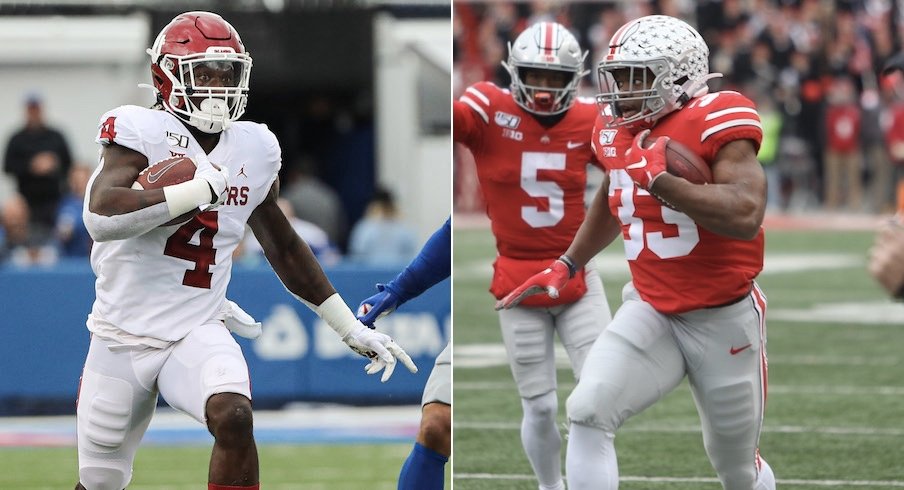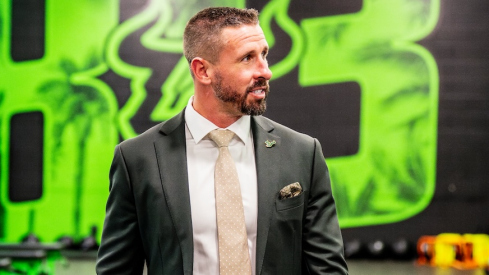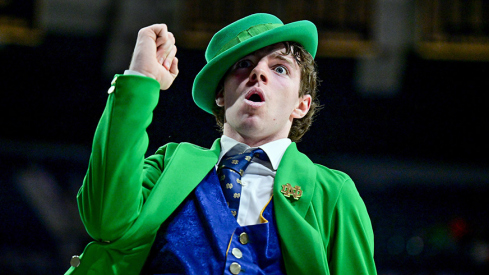Time after time, J.K. Dobbins rose to the occasion in important moments last fall.
He took 31 carries for a season-high 211 yards and four touchdowns in Ohio State’s 56-27 win against Michigan. He helped beat Penn State with 157 rushing yards and two touchdowns. He rushed for 163 yards and two touchdowns versus Wisconsin in the regular season, then totaled 172 rushing yards and a touchdown to topple the Badgers in the Big Ten title game later in the year. His drops in the Fiesta Bowl haven’t been completely forgotten, yet he managed to tally 174 rushing yards and a touchdown while averaging 9.7 yards per carry and adding six receptions in a six-point loss to Clemson.
Dobbins became a big-game back. He was someone Ryan Day could call on and know something good would happen for his team.
It wasn’t always like that. The prior year, Dobbins faced six teams ranked at the time of kickoff. In the first top-25 matchup against TCU, he thrived, taking 18 carries for 121 yards. But in the other five 2018 games versus ranked opponents, he maxed out at four yards per carry and 68 rushing yards. Some of that had to do with offensive line issues and playcalling, but Dobbins also later said he didn’t feel like himself that season. He hadn’t yet turned into the big-game weapon he eventually became one season later.
The Buckeyes, with Dobbins now taking handoffs from Lamar Jackson with the Baltimore Ravens, need Master Teague and Trey Sermon to take a similar trajectory.
Neither of the two tailbacks expected to take the brunt of the carries in Ohio State’s backfield this season have consistently run as well as they’ll need to in matchups with top-flight opposition so far in their college careers.
“J.K. was a great example for me of how to prepare and how to be ready for those moments like that,” Teague said.
He’ll have plenty of time to show off what he learned this fall, hoping to juxtapose it against how he ended the 2019 season.
Through the first 10 games of last fall, Teague took 114 carries for 744 yards, averaging 6.5 yards per rush. Most of his touches came late in games, often offering him chances to run through tired or backup-filled defenses. In those moments, he thrived. In eight of the 10 victories, he exceeded five yards per carry.
When the season’s conclusion neared, however, his production slipped. He recorded 21 carries for only 45 yards – an average of 2.1 yards per rush – in end-of-year matchups with Penn State, Michigan and Clemson. Against Wisconsin in a more-competitive-than-anticipated Big Ten title game, he didn’t rush the ball at all for the first time in the season.
Teague’s career-worst yards-per-carry average came in the Fiesta Bowl when he took seven carries for only nine yards.
“That definitely wasn't a performance I want to have,” Teague said. “You hate to go through something and have to learn from it. You like to learn first and then go from there. But definitely, I think it's something that I've thought about and want to make sure that I display that I can make those plays – I can make big plays in the heat of the moment, in those heated games. In the big games, I can still contribute and make a difference. Definitely, that's one of the things I have thought about and I feel like I'll definitely do better with that this year.”
Teague, a 5-foot-11, 225-pound tailback who clocked a 4.31-second 40-yard-dash time in high school, says he didn’t feel as though he was his best last season.
His goal? It’s fairly simple: “Just continuing to prove to my teammates, to this university, to myself that my capabilities are elite.”
To do so, Teague wants to become a danger to the top-of-the-line defenses he struggled with last year.
Sermon didn’t go through quite the late-season slog that Teague experienced. Injuries didn’t even allow him to get onto the field that late in the year, limiting him to 54 carries for 385 yards and four touchdowns as a junior before opting to transfer from Oklahoma.
He has, however, shown somewhat similar signs of inconsistency when facing high-level competition. As a Sooner, Sermon faced nine teams ranked in the top 25 at the time, averaging more than four yards per rush in four of the games.
- More than four yards per carry: 2017 vs. Oklahoma State (10 rushes, 81 yards, 1 touchdown), 2017 vs. TCU in Big 12 championship (10 rushes, 63 yards), 2017 vs. Georgia in Rose Bowl (2 rushes, 34 yards), 2018 vs. Texas (9 rushes, 54 yards, 1 touchdown)
- Fewer than four yards per carry: 2017 vs. Ohio State (17 rushes, 62 yards), 2017 vs. TCU (3 rushes, -1 yard), 2018 vs. West Virginia (5 rushes, 12 yards, 1 touchdown), 2018 vs. Texas in Big 12 championship (18 rushes, 65 yards, 1 touchdown), 2018 vs. Alabama in Orange Bowl (9 rushes, 19 yards, 1 touchdown)
At Ohio State, Sermon will try to make his standout performances more consistent. That’ll be the expectation from Tony Alford, the team’s sixth-year running backs coach who doesn’t hide from the fact that the bar for running backs in Columbus is about as high as anywhere else in the country.
“I am comfortable and confident in Master and obviously with Trey as well,” Alford said. “If those guys couldn't play winning football here, and not just winning football but at the rate of speed that we feel we need to have to be successful, we wouldn't bring him here. It's that plain and simple. Not only does every need to understand, but kids themselves first and foremost need to understand. But here's the expectations and they are high and we make no apologies for that.”
Too many all-time great tailbacks have walked into Ohio Stadium wearing Buckeyes jerseys for Alford to think any differently.
“The one thing you talk about is people always say, ‘How are you going to fill this guy's shoes and how is he going to fill that guy's shoes?’ But that's college football, right?” Alford said. “At one point in time, we had Carlos Hyde. Then it was (Ezekiel Elliott). Then Zeke left and Mike (Weber) filled in and did some good things and J.K. It's the world we live in. That's why young men come here. When it's their turn and they get that tap on the shoulder that they're there to perform and do their job and do it at a high, high level and win games and compete for championships. That's why you come to Ohio State.”
It’s why Teague chose to become a Buckeye and why Sermon chose to finish his collegiate career in Columbus. To become next in a long line of successful tailbacks to wear Ohio State uniforms.
As they attempt to reach the success of their predecessors, including most recently Dobbins, they’ll both aim to consistently flourish versus Ohio State’s toughest opponents. And, of course, they won’t have to wait long to do so.
A road date with top-10 Penn State awaits on Oct. 31.
Credit for Sermon photo: Jay Biggerstaff-USA TODAY Sports


